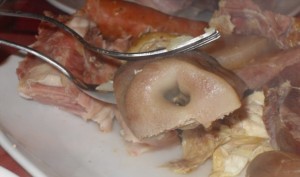
Nose of Cooked Pork
A gentle flame heats the water and a small lump of unto, the yellowish fat that covers and protects a pig’s intestines. The first to go in the pot are the lacón or salted leg of pork, the ribs and the belly pork. O Porco, as its known here, is a noble beast that in darker times saved more lives than penicillin and who, with the sole exception of Lalín (Pontevedra), nobody has had the decency of honouring in the form of a sculpture or statue. On the other hand there’s hardly a town across Spain that can call itself a town without its Avenida or Calle del Dr. Fleming.
The cachucha or cacheira, cured pig’s head, in winter often seen grinning from store-front windows, lurid feather boa round its neck, rayban wayfarers and cohiba cigar in its mouth, is the proud protagonist of this ancient winter ritual. Other cured bits thrown into this pantagruelic olla will invariably include the tail, snout, trotters and tongue. When the pork is ready it’s the turn of the corn-fed hen and the ternera, tender young beef, the huge kennebec potatoes, the grelos or turnip/collard greens, the chickpeas and the chorizos.
After two hours on the stove the cocido is laid out on several large platters, a gorgeous tapestry of colour, flavour and aroma. Cocido is communal eating par excellence, to be devoured slowly but surely, until you’re literally morado or purple faced. A fanfare for the common man, the cocido can be gallego, maragato, extremeño, madrileño, catalán, andaluz, manchego, vasco and navarro. Gastronomic federalism in action, a recipe for tolerance and mutual respect. All these cocidos are quite similar, yet at the same time very different, very much like Spain itself.






